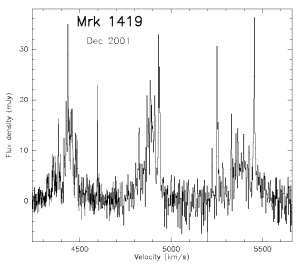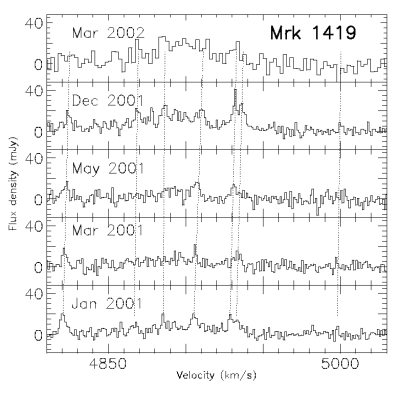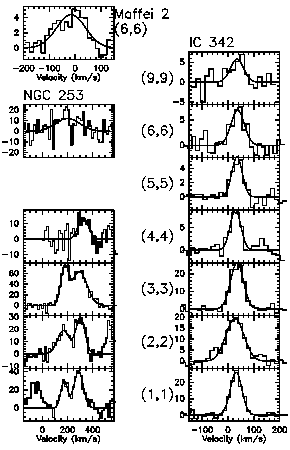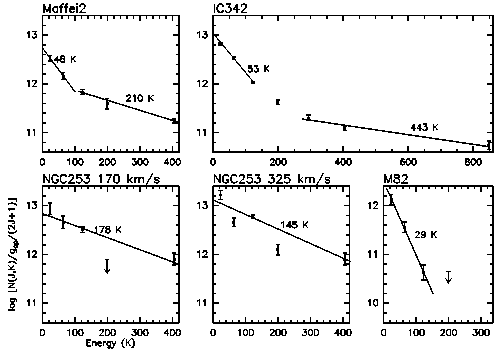|
 Fig. 1: Spectrum of a typical accretion disk maser. |
H2O Megamasers in Active Galactic Nuclei and Starbursts
Extragalactic 22GHz H2O masers allow to map accretion disks in AGN, to determine the mass of the supermassive nuclear object, to obtain direct geometric distances to galaxies (and, thus, to determine the Hubble constant), to study the interaction between nuclear jets and dense molecular material, and to measure proper motions of maser spots in the Local Group. During the past three years, seven H2O `megamasers' and three `kilomasers' were discovered with the Effelsberg 100-m telescope.
Fig. 1 shows the spectrum of a typical accretion disk maser. Maser emission is observed both near the systemic velocity, arising from clouds at the near side of the disk, and from "satellite lines" with velocities several 100 km/s w.r.t. systemic, arising from gas at the tangent points with rotational velocities directed towards and away from earth. Although not yet observed in Mrk1419 (NGC262), the satellite lines should show an accurately Keplerian rotation curve. The recessional velocities of the near systemic features are observed to be increasing at a rate of several km/s per year (Fig. 2). This increase of velocity results from the centripetal acceleration of clumps of gas in the annulus as they move across our line of sight to the central core.
 Fig. 2: The recessional velocities of near systemic features are observed to be increasing at a rate of several km/s per year |
From the velocity difference between `high velocity' and systemic features the rotation velocity (Vrot) is determined. The drift (centripetal acceleration) of the systemic masers in combination with Vrot then gives the radius R of the torus. R and V_rot yield the mass of the enclosed supermassive object, which in the case of Mrk1419 should be near 107 solar masses. Only the distance estimate, when linear scales have to be compared with angular scales, requires interferometry.
Ammonia Observations towards Nearby Galaxies
Ammonia (NH3) is the temperature tracer of extragalactic molecular gas. With a single telescope-receiver configuration at 18-26 GHz, a large number of NH3 inversion transitions can be measured that cover an enormous range of molecular excitation and that allow us to calculate relative populations that are mainly determined by collisional processes and thus, the rotational temperature, from which the kinetic temperature of the gas can be deduced. While until recently, only IC342 could be studied in detail, the new K-band receiver and AK90 autocorrelator at Effelsberg lead to the detection of several additional galaxies, among them Maffei 2 and the starburst galaxies NGC253 and M82.
 Fig. 3: NH3 spectra up to 848 K above the ground state in IC342. |
Fig. 3 shows some of the spectra up to 848 K above the ground state (the (9,9) line towards IC342). Fig. 4 shows plots of "normalized" column density versus energy above the ground level. The (negative) slope of the lines serves as a measure of the rotational temperature that provides a lower limit to the kinetic temperature. Obviously, there is a drastic difference between the temperature in the two starburst galaxies, with large quantities of relatively warm gas in NGC253 and small amounts of relatively cool gas in M82. This can be interpreted in terms of the evolutionary stage of the respective starburst. In M82, the ammonia emission arises from a few well shielded dense clumps that were not yet evaporated by the large number of newly formed massive stars. The starburst environment in NGC253 appears to be younger so that a large number of molecular clouds with siginificant ammonia emission is still present. The heating to more than 100 K may be provided by shocks, ion-slip or cosmic rays.
 Fig. 4: "Normalized" column density versus energy above the ground level. |
Interferometric measurements of these nearby galaxies with angular resolutions of 2-15 arcsec are presently reduced. Recent ammonia deections at redshifts of 0.7 and 0.9 are also analyzed.
Carbon Monoxide Observations
M82, NGC253, and NGC4945 are worth studying in detail because they are the nearest starburst galaxies and the brightest IRAS point sources beyond the Magellanic Clouds. In addition to CO multilevel studies of M82 (Mao et al. 2000) and NGC253 (Harrison, Henkel, Russel 1999), the spatial and kinematical correlation between CO J=2-1 and HI was studied with common spatial and velocity resolution (23 arcsec and 6 km s-1, respectively) in NGC4945 (SEST and ATCA). Two spiral arms and a nuclear bar could be identified in this edge-on (i=78°) galaxy, thus providing important insights into the large scale structure of the object. The amount of "dark matter" appears to be comparable to the total disk mass within a radius of 620 arcsec (Ott et al. 2001).
|
|
| 30 August 2005 |
